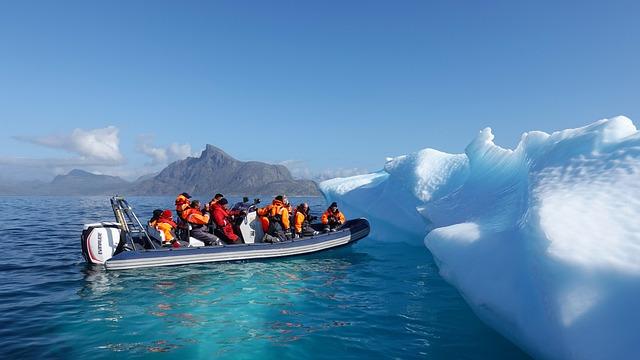Understanding the Mechanisms of Air-Sea CO2 Change within the Strait of Gibraltar
The intricate dance of air-sea CO2 alternate within the Strait of Gibraltar is influenced by a number of components that contribute to the area’s distinctive biogeochemical dynamics.Chief amongst thes are temperature, salinity, and currents, which all play pivotal roles in figuring out how carbon dioxide enters or exits the ocean. coastal upwelling, occurring because of the interplay of Atlantic and mediterranean waters, enhances the blending of floor and deeper waters, subsequently influencing the atmospheric equilibrium of CO2. The variation in sea floor temperature not solely impacts the solubility of CO2 but in addition modulates organic productiveness, with phytoplankton blooms appearing as important carbon sinks throughout sure intervals of the 12 months.
Moreover, the wind dynamics within the area additionally vastly contribute to CO2 alternate. Robust winds can facilitate elevated fuel switch charges, enhancing the absorption of atmospheric CO2 into the seawater.In distinction, calmer situations could result in a build-up of CO2 within the floor layer, thereby decreasing the gradient needed for efficient fuel alternate. The next desk summarizes these essential components affecting air-sea CO2 dynamics:
FactorImpact on CO2 ExchangeTemperatureAffects fuel solubility and organic activitySalinityModulates density, influencing present patternsWindsEnhances fuel switch charges in turbulent conditionsCurrent DynamicsFacilitates upwelling and horizontal transport of CO2
The Position of Ocean Currents in Carbon Sequestration

Ocean currents play a pivotal function in regulating the alternate of carbon dioxide between the ambiance and the ocean, appearing as conduits for the motion of this greenhouse fuel. In areas such because the Strait of Gibraltar, have been two giant our bodies of water converge, currents considerably affect the dynamics of air-sea CO2 alternate. These currents facilitate the vertical mixing of water,resulting in nutrient-rich upwellings that not solely assist marine life but in addition improve the ocean’s capability to soak up carbon dioxide from the ambiance. The stratified nature of the water column on this area permits for environment friendly transport of carbon, finally affecting each marine ecosystems and the worldwide carbon cycle.
Take into account the next components that reveal how currents improve carbon sequestration:
Upwelling Zones: Areas the place nutrient-laden waters rise towards the floor, encouraging marine phytoplankton blooms that take up CO2 throughout photosynthesis.Lengthy-Vary Transport: Currents transfer carbon-rich waters to deeper ocean layers, the place it will probably stay sequestered for hundreds of years.Temperature Results: Hotter waters can maintain much less CO2, whereas colder currents facilitate larger absorption charges.Present TypeImpact on CO2Surface CurrentsFacilitate preliminary CO2 alternate with the ambiance.Deep CurrentsTransport carbon to the ocean depths for long-term sequestration.
Affect of Seasonal Variations on CO2 Ranges within the Strait

The differences due to the season within the Strait of Gibraltar considerably affect atmospheric and oceanic CO2 ranges, making a dynamic interaction that impacts local weather regulation. Throughout the hotter months, photosynthetic exercise will increase as a consequence of elevated gentle availability and nutrient upwelling, resulting in a marked lower in floor CO2 concentrations. Conversely, the colder months experiance an increase in CO2 ranges, primarily pushed by organic decay processes and decreased photosynthetic uptake. These fluctuations illustrate the strait’s function as a organic filter, the place the stability between organic exercise and fuel alternate is essential for understanding international carbon cycles.
Furthermore, the bodily traits of the water, influenced by seasonal temperature adjustments and stratification, additional complicate CO2 alternate. The next components play a vital function:
temperature variations: Greater temperatures result in elevated solubility of CO2, impacting fuel alternate charges.Mixing dynamics: Seasonal winds can improve vertical mixing, subsequently influencing the distribution of CO2 within the water column.Nutrient availability: Seasonal nutrient provide influences phytoplankton development, altering CO2 uptake charges.
To encapsulate the that means of those differences due to the season,the next desk summarizes common CO2 ranges all year long:
MonthAverage CO2 Stage (µmol/kg)January220April195July180October210
These insights improve our understanding of the intricate interactions between seasonal patterns and CO2 dynamics,emphasizing the Strait of Gibraltar as a crucial area in international carbon administration methods.
Mitigation Methods to Improve Carbon Uptake in Coastal Waters

Enhancing carbon uptake in coastal waters presents a chance to leverage pure processes for local weather mitigation. Among the many most promising mitigation methods are:
Restoration of Mangroves: These coastal ecosystems are recognized for his or her excessive carbon sequestration potential. By restoring present mangrove forests and stopping their degradation, we are able to shield crucial carbon sinks.Seagrass Meadows: Much like mangroves, seagrasses seize carbon by the method of photosynthesis, with the additional advantage of stabilizing sediments and enhancing biodiversity.Shellfish Aquaculture: Sustainable cultivation of shellfish can promote carbon uptake whereas offering financial advantages to coastal communities. the shells themselves additionally contribute to carbon storage after they disintegrate.Marine Protected Areas (MPAs): Establishing MPAs helps protect very important marine habitats and fauna that contribute to carbon biking and the general well being of coastal ecosystems.
Alongside these methods, revolutionary approaches akin to carbon credit score methods may incentivize coastal safety and restoration. Importantly, collaborative governance fashions—integrating native, nationwide, and worldwide stakeholders—are important for efficient implementation. The desk under summarizes potential advantages and challenges related to every technique:
StrategyBenefitsChallengesMangrove RestorationHigh carbon sequestration, habitat for wildlifeLand use conflicts, long-term administration requiredSeagrass Meadowsenhanced biodiversity, coastal protectionVulnerability to local weather change, restricted awarenessShellfish aquacultureEconomic alternatives, carbon storageoverharvesting, water high quality concernsMarine Protected AreasConservation of marine biodiversity, ecosystem resilienceFunding, compliance, and enforcement challenges
Integrating Analysis Findings into Local weather Coverage and Conservation Efforts

The intricate dynamics of air-sea CO2 alternate within the Strait of Gibraltar current crucial insights for policymakers and conservationists alike.Understanding the mechanisms behind this alternate permits for the progress of more practical local weather insurance policies that deal with carbon dioxide emissions. Analysis signifies that the area displays distinctive traits as a consequence of its geographic and oceanic situations, which may affect the general carbon cycle. By integrating these findings into local weather motion methods, decision-makers can prioritize areas the place elevated conservation efforts can considerably mitigate local weather change impacts.
Furthermore, collaborative initiatives that contain native stakeholders, scientists, and authorities our bodies can result in revolutionary options for managing marine ecosystems. Efficient methods could embody:
Monitoring Carbon Sequestration: Common assessments to trace adjustments in CO2 ranges.Protected Marine Areas: Establishing zones that assist biodiversity whereas enhancing carbon uptake.Public Consciousness Campaigns: Educating communities about their function within the carbon cycle and emphasizing sustainable practices.
As an instance how these measures can unfold in observe, take into account the next desk summarizing key motion factors:
Motion PointObjectiveData CollectionEnhance understanding of CO2 dynamics within the regionStakeholder EngagementFoster collaboration for efficient coverage implementationFunding for researchSupport research exploring local weather impacts and options
These concerted efforts not solely sharpen the concentrate on decreasing carbon footprints but in addition emphasize the symbiotic relationship between human actions and marine well being within the Strait of Gibraltar.
Future Instructions for Air-Sea CO2 Research within the Mediterranean Area

The way forward for air-sea CO2 research within the Mediterranean area guarantees to yield essential insights that may inform local weather change mitigation methods. As researchers proceed to untangle the complexities of carbon flux dynamics in these waters, a number of key areas of focus are rising:
Enhanced Monitoring methods: Integration of superior satellite tv for pc monitoring methods can present full information on floor CO2 concentrations, serving to to map spatial and temporal variations extra successfully.Lengthy-term Ecological Impacts: Investigating how shifts in air-sea CO2 alternate affect marine ecosystems will likely be important for predicting future biodiversity adjustments.Socio-Financial implications: Analyzing the connection between coastal communities and adjustments in marine carbon dynamics can positively assist in formulating insurance policies for sustainable growth.
To facilitate these endeavors, collaborative worldwide analysis initiatives may play a pivotal function. Establishing networks for sharing information and methodologies will improve the collective understanding of regional carbon biking. Moreover, the incorporation of public engagement and citizen science can broaden the impression and outreach of ongoing research. The desk under outlines potential collaborative frameworks and their advantages:
Collaboration FrameworkKey BenefitsIntergovernmental Analysis ProjectsPooling assets and information throughout borders to sort out shared challenges.Educational PartnershipsLeveraging numerous experience and services for superior analysis outcomes.Neighborhood-Led InitiativesEmpowering native populations to take part in information assortment and consciousness applications.
To Wrap It Up
the intricate dynamics of air-sea CO2 alternate within the Strait of Gibraltar underscore the crucial function this area performs in international carbon biking. As rising findings reveal,the interaction between atmospheric situations and oceanic processes influences not solely native ecosystems but in addition broader local weather patterns. Understanding these interactions is important for creating efficient methods to mitigate local weather change and handle marine assets. With ongoing analysis and elevated monitoring efforts, scientists proceed to unravel the complexities of this very important marine hall. As we deepen our comprehension of the Strait of Gibraltar’s function within the local weather system, it turns into more and more clear that defending this distinctive environment is crucial for the well being of our planet. The findings introduced right here pave the way in which for future exploration and underscore the urgency of knowledgeable policy-making as we confront the multifaceted challenges of a altering local weather.
Source link : https://europ.info/2025/03/02/gibraltar-2/air-sea-co2-exchange-in-the-strait-of-gibraltar-frontiers/
Writer : Sophia Davis
Publish date : 2025-03-02 10:50:00
Copyright for syndicated content material belongs to the linked Source.


